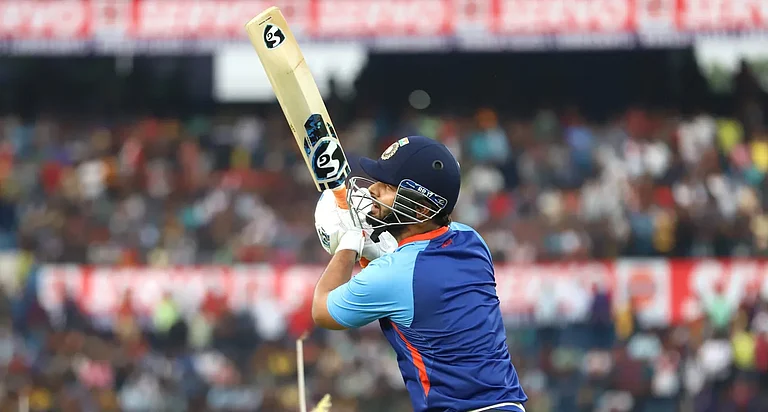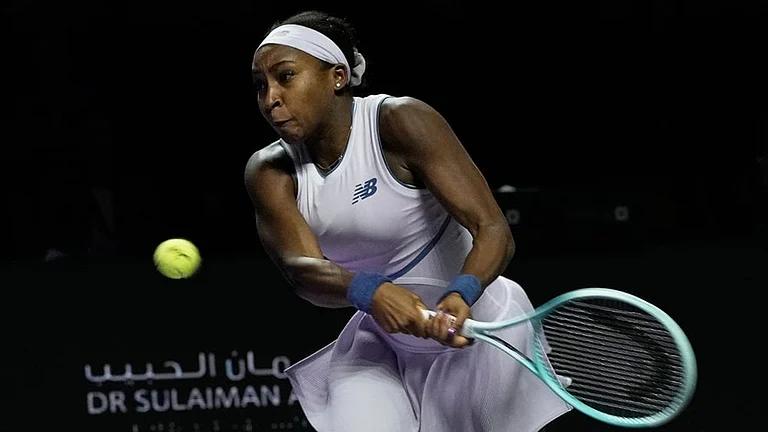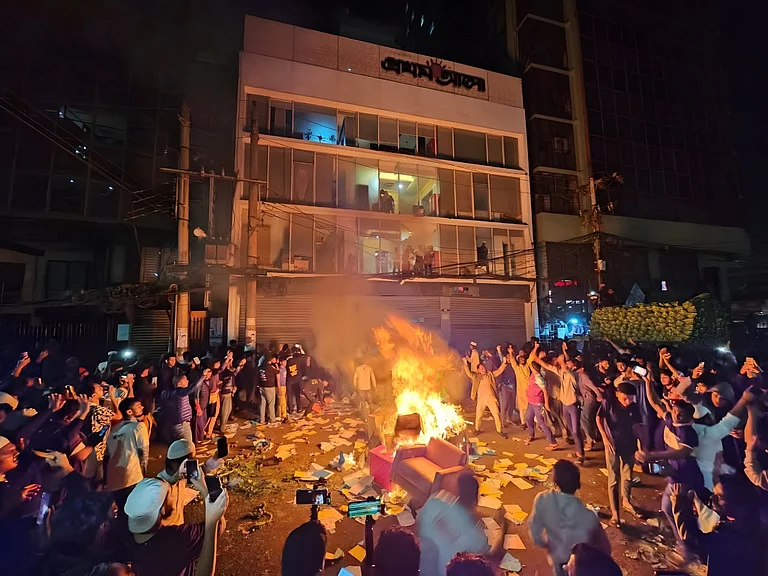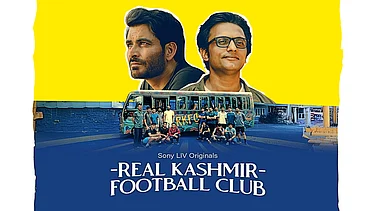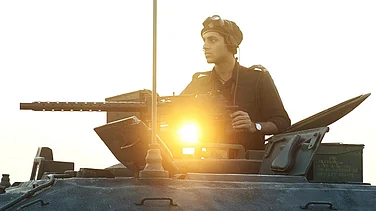The year 1995 is centennially emblematic. If you flash it backwards by a century, you find yourself at the birth of the moving image—at the Salon Indien du Grand Café in Paris, where the Lumiere Brothers presented their first paid public screening of ten short films, on December 28, 1895. Soon these shorts were to travel across the globe as ‘wonders of the world’. Incidentally, this particular Paris programme had missed The Arrival of a Train at La Ciotat Station, but well, the steam-engine carrying passengers did arrive at this station near Marseille one hundred years prior to the train that had arrived at the small Swiss railway station of Zweisimmen in Adiya Chopra’s film Dilwale Dulhania Le Jayenge (Braveheart Wins the Bride, 1995).
Its story is about Raj (Shahrukh Khan), a rich Londoner who goes on a month’s vacation to Europe, including Switzerland. Another London-based girl named Simran (Kajol) also goes on a similar vacation tour. Both are Punjabi NRIs living in the UK. Raj distracts Simran by cracking jokes and makes her miss the train at a La Ciotat-like small railway station, but in Switzerland. That was Zweisimmen. They then get stuck somewhere together on their whirlwind journey. By the time they return to London, they have fallen in love. As scripted, Simran’s marriage had already been arranged by her patriarchal father (Baldev Singh) with someone in the Punjab, whom she had never seen before. Raj has no option but to win Simran away from her ferocious father and the man she never wanted to marry. Wading through wedding songs (including Aye meri zohra jabeen from Yash Chopra’s elder brother B.R. Chopra’s 1965 film Waqt) and finally through bloody fights at a small Indian railway station, named Apta, the film gets its happy end—Raj, with his face badly bloodied, pulls a running Simran, still in bridal dress, into the compartment. Thus was consummated a film about arriving and perhaps also departing: a film that was seen as a ‘game-changer’, one that incorporates several nostalgic old and new exchanges within itself.
ALSO READ: Silver Jubilation
For example, the 1974 Chor Machaye Shor song Le jayenge, le jayenge, dilwale dulhaniya le jayenge is recycled into the DDLJ title 21 years later as a ‘feelgood’ flashback in Alpine mountains and meadows, away from the mustard fields of the Punjab. While nostalgia for the motherland remains intact, fascination for foreign lands among the rising middle classes of 1990s India has found its groove. But DDLJ wasn’t An Evening in Paris or Love in Tokyo, that first thrilling foray abroad of the mid-’60s—that formula was plotted on the much more mobile, globalised world of the mid-’90s! We acted as we ‘owned’ it. By now the Federal Republic of Switzerland has not only a lake but also a train named after Yash Chopra, the producer-director who reinvented a new idiom for romance in Indian cinema. Switzerland was promoting its tourism industry at a time when, for middle-class Indians, for political reasons, Kashmir had become an impossible destination for love and romance. The landscape of Kashmir ki Kali (1964) was now far behind: Switzerland was closer. Yash Chopra’s first foray into Switzerland came with Faasle (1986), which he shot in Bombay studios as well as in Kashmir and Switzerland for outdoor scenes that he intercut, creating an illusion that Switzerland was part of India, as if! Well, almost.
As for locomotives, they have been part of motion pictures right from their birth—and why not? They propel the plot (catching or missing them) and create memories on the move. Most importantly, they move—even via the back projection trick—and thus help produce the thrill for action films. The Burning Train (1980), Hindi’s cinema’s exemplar of that genre, took Sholay’s coal-fired train engine shots to a new scale and had the whole Delhi-Bombay Super Express ablaze—a sort of La Ciotat on fire!

But 1995 was also the year of Mani Ratnam’s Bombay (in pic), originally a Tamil film that told the story of an inter-religious family in Bombay caught up in the terrible communal carnage of 1992-93. Dubbed in Hindi, Telugu and Malayalam, Bombay was the second in Mani Ratnam’s trilogy of films that depicted human relationships against a background of Indian politics, including Roja (1992) and Dil Se.. (1998). Bombay was released on March 10. Seven months later, on October 25, DDLJ was released. Like those arrivals and departures of trains, these releases—realisations of contemporary society’s points of pain and pleasure—produce uncanny temporal templates.
ALSO READ: Postcards From The Newsroom
Writing this in 2020, the juxtapositions seem almost scripted. It was also in 1895 that the Constitution of India Bill was drafted. Also called the Swaraj Bill, and said to have been drafted by Lokmanya Tilak, it was a document that expressed the increasingly vocal demands by Indians for self-government within the British Empire. And it was Tilak who described India’s first silent feature film Raja Harishchandra (1913) directed by Dadasaheb Phalke, as a ‘swadeshi’ film. Kolhapur-based Maharashtra Film Company’s founder and innovative filmmaker Baburao Painter and his cousin Anandrao devised a self-made camera, which too Tilak greeted as ‘swadeshi’. It was this camera that was used to shoot Painter’s 1920 silent film Sairandhi, celebrating its centenary this year.
Ironically, the good old slogan of ‘swadeshi’ continues to ring even today, but amidst a complicated and contradictory globalised network, it has a different ring now—one of jingoism. Also, the haqeeqat of Chetan Anand’s 1964 film Haqeeqat is not the haqeeqat of J.P. Dutta’s Border (1997) or of Aditya Dhar’s Uri: the Surgical Strike (2019). Like romance, josh keeps changing its timbre and texture temporally. But Haqeeqat, considered one of India’s greatest B&W war films, was not only a representation of war, but a dramatic retelling of the impact war has on the common soldier. Incidentally, this story too is in continuum, after almost six decades.
Such a paradoxical firmament the snowy Himalayan terrains proved—hosting the whole gamut from romance to war. As the trope of violence coloured our snows, romance fled to the snows of Switzerland—truly, an escapist act. While reality overtook India, pure romance found its pristine mountains and meadows, tulips and titillations, exuberance and eroticism. Around the epitomic DDLJ, we got a whole constellation of feel-good films—Yash Chopra’s Dil To Pagal Hai (1997), Aur Pyaar Ho Gaya (1997), Kuch Kuch Hota Hai (1998), Taal (1999), to name only a few, catering largely to the burgeoning Indian diaspora market.
ALSO READ: At Swim, Two Birds Perched On Latticed Sites
No longer those sorrowful songs of the Raj-Dev-Dilip trio; no more Main zindagi mein hardam rota hi raha hoon (All I’ve done in my life is weep). From 1949’s Barsaat to 2019’s Gully Boy, one wonders where all the tears evaporated! Paying hefty ticket prices for cozy multiplex seats, the middle class’s wishes could be captured in some choice Bambaiyya slang: they wanted paisa vasool, just time-pass; no more bheja fry (read: cerebral stuff). The vibe had to match with popcorn-munching and Coke-sipping, after all. Bollywood sensed the mood and so the cinema experience itself got repurposed in pleasurable, consumerist ways. Breezy romances were soon joined by a host of comedies and thrillers. We even got romantic comedies titled Bheja Fry (2007), Paisa Vasool (2017) and Timepass, a 2014 Marathi film directed by Ravi Jadhav about teenage love set in the 1990s that was remade in Telugu as Andhra Pori. Yes, Paisa Vasool was also a Telugu film and they were all box-office hits. Times were changing via the 1990s!

And yet, somewhere the 1958 spirit of Mughal-e-Azam’s Pyaar kiya toh darna kya could sustain for its feminine feisty. This song line also became a film title in 1998 via a Sohail Khan venture which starred DDLJ’s Kajol but now with Salman Khan in comic-romantic garb. By 1995, the Angry Young Man of Zanjeer or Deewar was increasingly tamed into a happy-go-lucky, law-abiding romantic chocolate persona. A Satya (1998) or a Maqbool (2003) were only the dark shadow of this sunlit character. On the rasa-masala thaali, it was the superficial comedy that went from peripheral thrill to main dish, occupying that space along with romantic, social, action-drama and thriller films.
ALSO READ: The Bully Wears A Tailored Suit
Thus, 1995 was also the year of Govinda-Karishma comedy Coolie No. 1, such a cult film that it was remade in 2020. In fact, the 1990s and the post-’90s are the David Dhawan-Govinda times. The semi-porn Raja Babu (1994) song Sarkai lo khatiya had signalled a shift in the nouveau riche’s tastes. On one front, the free-market economy was empowering the big fish to swallow up smaller ones; ‘B’ and ‘C’ grade films were disappearing, and the mainstream ‘A’ graders were increasingly absorbing the former’s vibe in their mise-en-scene. Aesthetic perceptions and preferences were changing. Adoor Gopalakrishnan said the other day that he could not imagine people watching cinema on their mobile phones—but the consumerist turn the ’90s imparted to cinema meant it was inevitably headed to the miniaturised status of an icon you click on a smartphone.
Quite a change from the 70 mm year of Emergency, 1975, which remains iconic in the history of Indian cinema. (Witness the difference in the word ‘icon’.) This single year produced the all-time curry western epic Sholay and the crime-classic Deewar, both starring Amitabh Bachchan among others, both written by Salim-Javed. The coming paradoxes of India were also prefigured that year when the low-budget Jai Santoshi Maa released, with unknown actors. This ‘B’ film, as big a hit as the blockbusters, turned a little-known mother goddess into a massively popular deity, especially among urban working-class women who started observing the goddess’s ritual fast on 12 consecutive Fridays and making offerings of chickpeas. Mythology had dominated Indian cinema in the silent era, but strange times prevailed in the vicennial 1975-1995! Along with globalisation and technological strides, the process of mythification sunk much deeper into the collective consciousness—1995 was also the year when Ganesha drank milk, a vision spurred by cinema’s new souten, television.

Jackie Shroff and Urmila Matondkar in Rangeela.
The next quarter-century offers a fragmented kaleidoscope—perhaps yet to offer a definitive script beyond the shattering itself, even if a New Cinema bobs in waters ruffled first by pirated DVDs and then illegal downloads. The digital has meanwhile taken over the analog completely. During April 2014-March 2015, some 82 celluloid (analog) films were certified by the Central Board of Film Certification. The following year, this number came down to 15. It is zero now. The option of making films on celluloid is closed because of the unavailability of raw stock, closure of processing labs—even the exhibition sector is losing its conventional projection systems.
ALSO READ: In The Beginning, There Was The Spider
Paradoxically, the technological hegemony also in some ways made democratisation/accessibility possible. In 1995, some 793 feature films in 22 languages were certified, and they were all celluloid. In 2019, that rose to 4,026 and 46 respectively, all in digital format. These numbers are minus the uncensored content shown on OTT platforms that millions of youngsters see on their mobile phones (they have now come under the I&B ministry and reportedly producers will have to apply for approval of the content they wish to stream). These platforms, as we know, branched into the production and release of short films, feature films, documentaries and web series themselves.
Well, in the plural, polyphonic, federal Republic of India, let a thousand flowers bloom in all kinds of ‘woods’—Bolly, Kolly, Tolly, Dholly, Molly—amidst a Babel of bhashas and bolis, many of which many of us may never have heard of before. Take Khortha, Nyishi, Paniya…. India also makes films in Hinglish! Back in 1995, while Raj and Simran were doing their tango on the Alpine meadows, somewhere in Kerala, the Man of the Story, Kunjunni in Adoor’s Kathapurushan, was feeling lonely and disillusioned, waiting for revolution to happen….
ALSO READ
Amrit Gangar is a Mumbai-based author, curator and historian.







